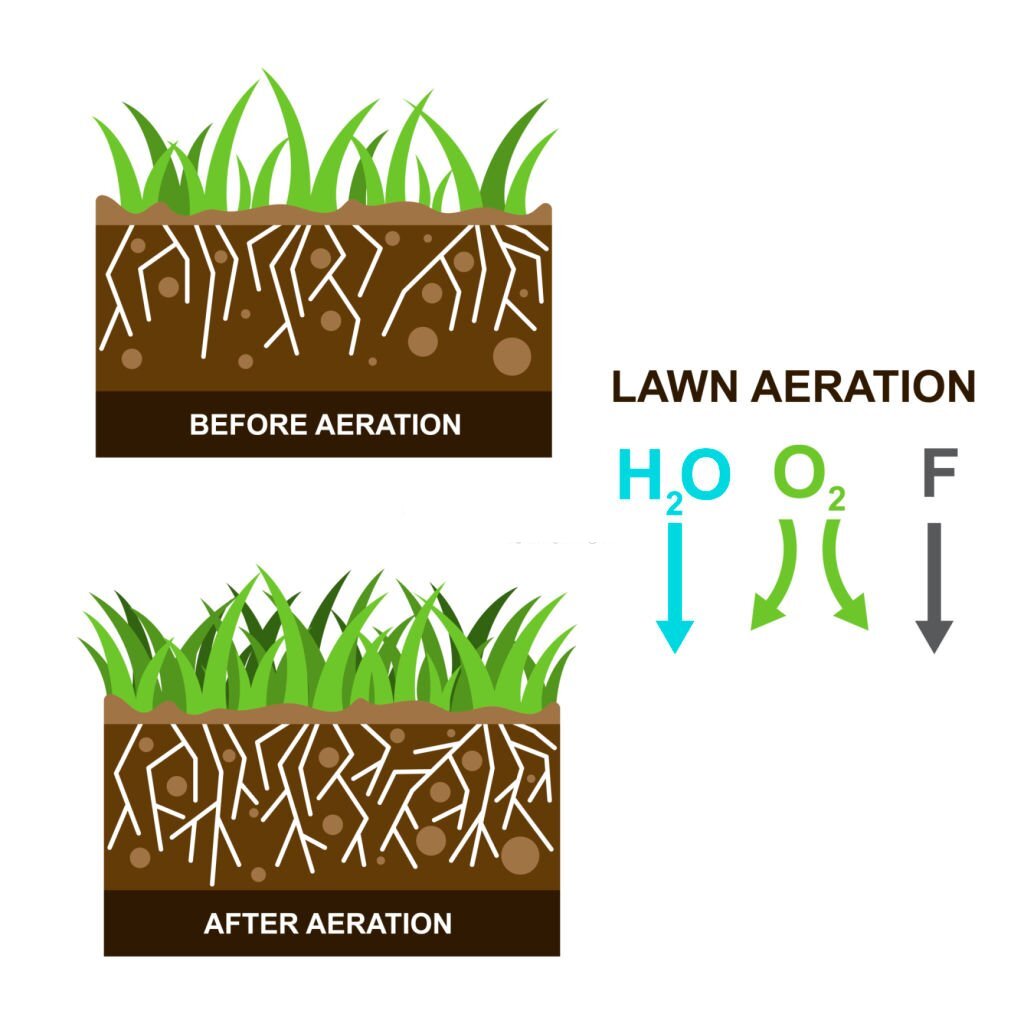Aeration Demystified: Why Your Lawn Needs It
You’ve tried everything; sod installation, overseeding, mulching, and you’re still seeing dry, yellow patches of grass all over your yard, and you can’t figure out why. As great as it is to provide nutrients for your yard, the key is ensuring it reaches your grassroots. That’s where aeration comes in. Let’s break down what it is and how to tailor the service to your yard.
Aeration Definition & Benefits
So, what is aeration? On a simple level, aeration is defined as the “introduction of air to a material.” On a landscaping level, aeration is the process of creating holes down into the soil to alleviate compaction so air, water, and nutrients can reach grass roots. When your soil is too compacted, nothing can get down there–and when lawn grasses are deprived of their basic needs, they begin to lose their color.
How Does Aeration Benefit My Lawn?
Aeration has many benefits, but there are four main ones: improved drainage, stronger grass, reduced thatch, and improved soil health. Improved drainage is always helpful in lawn care, especially if you have clay soil. Aeration can help reduce puddling so your lawn gets the water it needs.
At its core, aeration helps more water, nutrients, and sunlight reach roots, which results in thicker and stronger grass. This process also improves grass hardiness, meaning it will stay green longer during dry spells.
Aeration can also help remove built-up thatch from your lawn. When aeration removes plugs of soil from your lawn, this process can also stimulate beneficial microbes that help decompose thatch.
Improved soil health is the biggest benefit of aeration. The service's main point is to loosen compacted soil so nutrients can fix stunted roots and poor grass growth. The soil plugs left behind after aeration can also break down over time and put those nutrients back into the soil.
 Aeration for Your Specific Lawn
Lawn care is not easy–after all, it’s not like your grass can talk to you and tell you what it needs. But there are ways to tailor aeration services to your lawn type and needs. Let’s talk about when to aerate based on your grass type and common aeration mistakes to avoid.
Aeration for Different Lawn Types
When it comes to aeration for different lawn types, the biggest difference lies in when you aerate. When aeration cool-season grasses, you want to stick to early spring or early fall–though early fall is most recommended. You want to ensure you aerate a month before the first frost when aerating in the fall. This is because cool-season grasses are at their strongest going into the cool weather, and they will have enough time to recover before winter begins.
Warm-season grass, on the other hand, benefits most from late spring or early summer aeration. This allows it to return from dormancy and establish deeper roots. Warm-season grasses are actively growing at this time, and they can recover quickly. You just want to ensure that you’re aerating before mid-July so the turf can become established before the hot temperatures of late summer.
Common Aeration Mistakes to Avoid
Homeowners make three common aeration mistakes that you should be warned about: over or under-aerating, aerating at the wrong time of the year, and neglecting post-aeration care.
Aeration for Your Specific Lawn
Lawn care is not easy–after all, it’s not like your grass can talk to you and tell you what it needs. But there are ways to tailor aeration services to your lawn type and needs. Let’s talk about when to aerate based on your grass type and common aeration mistakes to avoid.
Aeration for Different Lawn Types
When it comes to aeration for different lawn types, the biggest difference lies in when you aerate. When aeration cool-season grasses, you want to stick to early spring or early fall–though early fall is most recommended. You want to ensure you aerate a month before the first frost when aerating in the fall. This is because cool-season grasses are at their strongest going into the cool weather, and they will have enough time to recover before winter begins.
Warm-season grass, on the other hand, benefits most from late spring or early summer aeration. This allows it to return from dormancy and establish deeper roots. Warm-season grasses are actively growing at this time, and they can recover quickly. You just want to ensure that you’re aerating before mid-July so the turf can become established before the hot temperatures of late summer.
Common Aeration Mistakes to Avoid
Homeowners make three common aeration mistakes that you should be warned about: over or under-aerating, aerating at the wrong time of the year, and neglecting post-aeration care.
 It’s fairly difficult to over or under-aerate, especially when you’ve hired a trained professional. Here are some things to avoid to make sure you don’t suffer the consequences of either:
It’s fairly difficult to over or under-aerate, especially when you’ve hired a trained professional. Here are some things to avoid to make sure you don’t suffer the consequences of either:
- Don’t aerate during extreme weather, such as droughts, high heat, winter, or when the ground is excessively wet or cold. These conditions make it difficult for grass to adjust and regrow.
- If you’ve installed sod in your yard, wait at least 12 months before aerating. You want to give the roots time to establish fully, and aerating too early could pull the sod up.
- Take your time. Rushing aeration results in turf tears, lawn damage, and equipment damage.
- Make sure your aerator is clean so as not to spread disease.
 How to Maintain Your Lawn to Maximize Benefits
All lawns need maintenance. To maximize the benefits of aeration, you want to keep up with regular mowing and weed removal. Wait 2-4 weeks to mow on newly aerated grass, but after that, it’s important to keep up with weekly mowing to encourage healthy growth. You also want to remove weeds as soon as possible, as aeration makes soil optimal for germination, and you want grass seed to germinate, not weeds.
Conclusion
Overall, aeration is just an advanced lawn care tactic; its results are unmatched. If you’ve been working to improve your lawn's health but haven’t seen the results, it’s very likely that the nutrients just aren’t reaching the roots. Aeration is a great way to open your lawn up. Don’t let a little soil compaction stand in the way of your perfect lawn.
How to Maintain Your Lawn to Maximize Benefits
All lawns need maintenance. To maximize the benefits of aeration, you want to keep up with regular mowing and weed removal. Wait 2-4 weeks to mow on newly aerated grass, but after that, it’s important to keep up with weekly mowing to encourage healthy growth. You also want to remove weeds as soon as possible, as aeration makes soil optimal for germination, and you want grass seed to germinate, not weeds.
Conclusion
Overall, aeration is just an advanced lawn care tactic; its results are unmatched. If you’ve been working to improve your lawn's health but haven’t seen the results, it’s very likely that the nutrients just aren’t reaching the roots. Aeration is a great way to open your lawn up. Don’t let a little soil compaction stand in the way of your perfect lawn.
 info@ekglawn.com
info@ekglawn.com